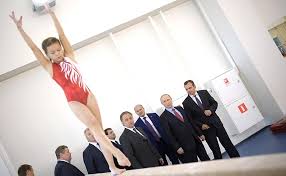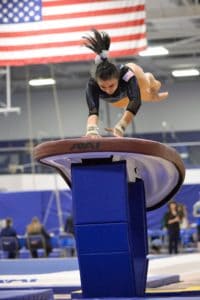This post may contain affiliate links. As an Amazon Associate I earn from qualifying purchases.
As some of the gyms around the country are opening back up, it’s been a while since most gymnasts have been on the equipment. That can be a really big deal to a gymnast returning to their sport! Gymnasts may have to deal with lost skills, changes to their body, lack of conditioning, and possibly overcoming fears that have developed due to being out of the gym.
When I was in high school, I took a month off gymnastics to travel abroad as part of a foreign exchange program. It was an amazing experience, and I wouldn’t trade it for anything. But when I returned to the gym after a month away, some of my previously learned skills started to seem downright scary to me.
I would balk. I would stand on the beam FOREVER and still not go backward. Some days, I would end up crying in the locker room. It took many months and several different approaches before I could finally work through my fears.
When I started coaching, I realized I would have to apply some of the same techniques with the gymnasts I coached. Some gymnasts seemed to have no fear, but others were terrified of a particular skill or event. The “no fear” gymnasts were labeled as courageous, and applauded by coaches, teammates, and parents. The fearful gymnasts were sometimes cast aside. Some coaches seemed to give up on them.
I was always fascinated by working with gymnasts to overcome their fears. Because I had lived through it myself as a gymnast, I felt uniquely qualified to help my athletes with it as well.

Why Do We Feel Afraid?
There is a scientific basis behind fear. Fear comes from a part of the brain called the amygdala. It is a primitive reflex, which activates when the body perceives a threat. When this reflex turns on, the body responds with an increase in heart rate, blood pressure, and alertness. This is what is commonly known as the fight-or-flight response. This response is also connected to the hippocampus, where memories are stored. Because of this connection, when the same stimulus occurs again, the body will usually have the same response. The more evolved part of the brain has difficulty overriding the amygdala, making it tough for our bodies to calm down these lower-brain reactions.
First Steps to Overcome Fear
So how can we get ahead of what our bodies naturally do in the face of something scary?
First, take a deep breath. Fear is not permanent! It’s always possible to work your way through a fear. Try not to let it get in the way of the rest of the practice. Also, don’t dwell on it. Remember all of the successes of the past, and previous triumphs over fear. You can do it again!
Next, take a step back. Many times, fear can dissipate through working on drills. For instance, if a tumbling pass is scary to land on the hard floor, is it better with a mat? Into the pit? On the tumble trak? On beam, try skills on a lower beam or a line on the floor, and gradually work back up to the high beam.
Another helpful strategy is to train your mind. Using relaxation strategies can help to calm the fear. Visualization is a very powerful tool that has been shown to improve many aspects of life. Visualizing yourself performing the skill perfectly, over and over again, can translate into real life the next time the skill is performed.
Finally, the only true cure for fear is ACTION! We’ll talk about this in just a minute.
What Coaches Can Do
Coaches, be patient with the gymnasts who are suffering through fear. These gymnasts really don’t want to be afraid. They wish they could “just do it” like some of their teammates seem to do so easily. First and foremost, they need a bit of understanding and grace.
Next, work with your gymnast to determine a plan of action to help them overcome their fear. It’s important to work together because the gymnast may be able to identify roadblocks that the coach hadn’t thought of. An example of this is one season when I was afraid to do my vault. At the time, we had an assistant coach who was new and inexperienced. I didn’t trust that she would be able to spot me correctly, and the situation led to a fear of vault. An honest conversation between myself and the head coach could have nipped this in the bud.
What if the gymnast doesn’t know why they are afraid? This is the case with many fears. If a coach-gymnast conversation doesn’t bring up any problems that may be interfering, it’s time to set a plan of action and test it out. The best way to overcome fear is to act.
What Gymnasts Can Do
As stated above, gymnasts should have an honest conversation with their coach if they are afraid. The first step to overcoming a fear is to identify barriers to performing the skill. The coach may have new or different ideas for learning the skill, and those could be shared with the gymnast during this conversation.
What if the gymnast is afraid of the coach? This can be a difficult situation, but it is important to bring up. If there is a team director or additional coach for the gymnast’s level, this person could be the first resource for the gymnast to seek out. Parents should be talking with their gymnast if they suspect a situation in which the gymnast is afraid of the coach. If the gymnast is nervous about talking to coaches or adults in general, the parent can help them learn these important conflict management skills. If the gymnast is afraid because she is in an abusive situation, that’s a different story. In that case, she should get out as soon as possible, and the parents should ensure that the appropriate authorities are notified.
Assuming that there is not an abusive relationship, the gymnast and coach can move forward together to determine a plan for overcoming the fear. As stated previously, action is the best medicine for fear. So what’s the best way to get into action when fear stands in the way?
Break it down.
Breaking down the skill into bite-size pieces allows for the gymnast to experience success and gradually overcome fear. The coach can provide drills to break down the skill further, or move the skill to a less threatening apparatus (for instance, from high beam to low beam).

Action Plan To Overcome Fear
Action is the cure for fear. But if taking action feels too difficult, a detailed plan can help. What should go into the plan?
First, set a goal to complete the skill causing the fear. This goal should have a date to successfully complete the skill (hopefully before the upcoming season!). This is also a good time to think of any supports the gymnast may need on her way to her goal. Write down the goal on paper.
Next, break it down into steps to take in order to achieve that goal. These steps can be broad, because they will be broken down further. Don’t forget to write the steps down too!
Finally, how many of each skill or drill should be performed at each practice in order to keep on track? Here’s where any other details can go. How many on the line, on the low beam with mats, on the low beam without mats, on the medium beam, etc? Write down this part of the plan, and don’t forget to include dates of each practice.
Need More Help?
Here are a couple of books and resources that may be helpful to anyone working through a fear. First, there is a children’s book by Ruth Soukup, who has done a LOT of research into fear, its causes, and solutions.
Next, there is a book which is more appropriate for adults and teenagers, also by Ruth Soukup. This book gets more in depth into fear archetypes, and is much longer.


A gymnastics journal is a great way for a gymnast to write down any thoughts she has about her fears, and also to note the small incremental progress she is making. This journal has spots to write down weekly practice notes, among other things.
If you’d like to check out an article about developing courage, click below:
Monday Motivation: What is Courage?
Dealing with a mental block? Read this one:
How to Overcome a Mental Block in Gymnastics
Remember to stay persistent and keep the end goal in mind. With a clear plan and consistent action toward the goal, fear will soon be a thing of the past!

